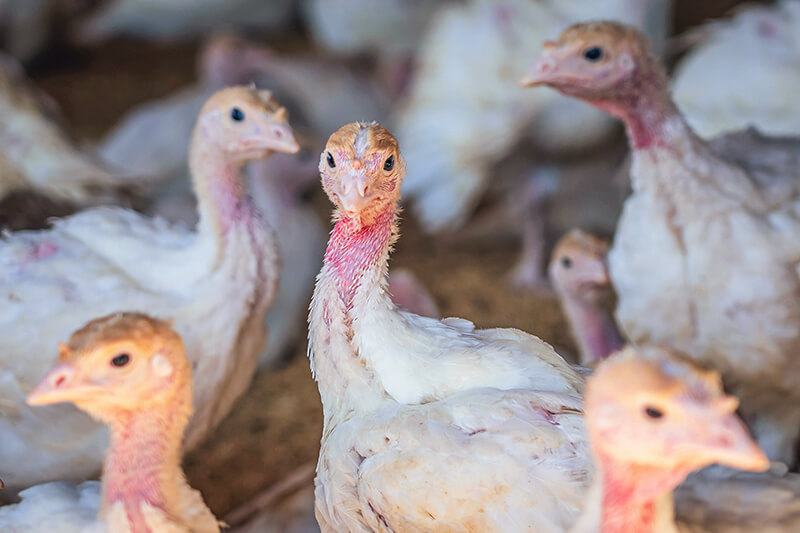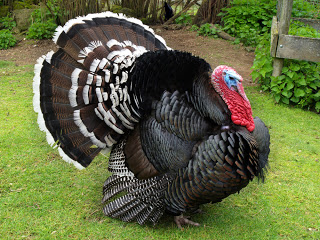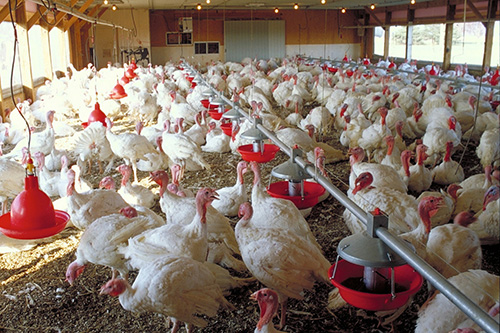A Rafter of Turkeys
Students investigate the domestication and life cycle of the turkey, discover how turkeys are raised on farms, and identify turkey products.

Background
Lesson Activities
Recommended Companion Resources
Credits
Author
Pat Thompson and Michele Reedy | Oklahoma Agriculture in the Classroom Organization and National Agriculture in the Classroom (NAITCO)
Sources
- http://www.nwtf.org/
- http://www.health.harvard.edu/
- http://www.agmrc.org/commodities__products/livestock/poultry/turkey-profile/
Standards
Indiana Content Area Standards
-
English Language Arts.Grade 3.RN.1
Read and comprehend a variety of nonfiction within a range of complexity appropriate for grades 2-3. By the end of grade 3, students interact with texts proficiently and independently.
- Key Ideas and Textual Support.3.RN.2.1: Ask and answer questions to demonstrate understanding of a text, referring explicitly to the text as the basis for the answers.
- Structural Elements and Organization.3.RN.3.1: Apply knowledge of text features to locate information and gain meaning from a text (e.g., maps, illustrations, charts, font/format).
-
English Language Arts.Grade 3.RV.1
Build and use accurately conversational, general academic, and content-specific words and phrases.
- Vocabulary in Literature and Nonfiction Texts.3.RV.3.2: Determine the meanings of general academic and content-specific words and phrases in a nonfiction text relevant to a third grade topic or subject area.
-
English Language Arts.Grade 3.W.1
Write routinely over a variety of time frames and for a range of discipline-specific tasks, purposes, and audiences; apply reading standards to write in response to literature and nonfiction texts.
- Writing Genres.3.W.3.3: Write narrative compositions in a variety of forms that a. Establish an introduction (e.g., situation, narrator, characters). b. Include specific descriptive details and clear event sequences. c. Include dialogue. d. Connect ideas and events using introduction and transition words. e. Provideanending.
-
English Language Arts.Grade 3.SL.1
Listen actively and adjust the use of spoken language (e.g., conventions, style, vocabulary) to communicate effectively with a variety of audiences and for different purposes.
- Discussion and Collaboration.3.SL.2.1: Engage effectively in a range of collaborative discussions (one-on-one, in groups, and teacher-led) on grade- appropriate topics and texts, building on others ideas and expressing personal ideas clearly.
- Discussion and Collaboration.3.SL.2.2: Explore ideas under discussion by drawing on readings and other information.
- Discussion and Collaboration.3.SL.2.3: Demonstrate knowledge and use of agreed-upon rules for discussions and identify and serve in roles for small group discussions or projects.
- Discussion and Collaboration.3.SL.2.4: Ask questions to check understanding of information presented, stay on topic, and link comments to the remarks of others.
- Presentation of Knowledge and Ideas.3.SL.4.1: Using appropriate language, report on a topic or text, or provide a narrative that organizes ideas chronologically or around major points of information, with appropriate facts and relevant, descriptive details, speaking at an understandable pace, in a clear, concise manner.
- Presentation of Knowledge and Ideas.3.SL.4.2: Create oral presentations that maintain a clear focus, using various media when appropriate to emphasize or enhance certain facts or details.
-
English Language Arts.Grade 4.RN.1
Read and comprehend a variety of nonfiction within a range of complexity appropriate for grades 4-5. By the end of grade 4, students interact with texts proficiently and independently at the low end of the range and with scaffolding as needed at the high end.
- Key Ideas and Textual Support.4.RN.2.1: Refer to details and examples in a text when explaining what a text says explicitly and when drawing inferences from the text.
-
English Language Arts.Grade 4.RV.1
Build and use accurately general academic and content-specific words and phrases.
- Vocabulary in Literature and Nonfiction Texts.4.RV.3.2: Determine the meanings of general academic and content-specific words and phrases in a nonfiction text relevant to a fourth grade topic or subject area.
-
English Language Arts.Grade 4.W.1
Write routinely over a variety of time frames and for a range of discipline-specific tasks, purposes, and audiences; apply reading standards to support reflection and response to literature and nonfiction texts.
- Writing Genres: Argumentative, Informative and Narrative.4.W.3.3: Write narrative compositions in a variety of forms that a. Establish an introduction, with a context to allow the reader to imagine the world of the event or experience. b. Organize events that unfold naturally, using meaningful paragraphing and transitional words and phrases. c. Use dialogue and descriptive details to develop events and reveal characters personalities, feelings, and responses to situations. d. Employ vocabulary with sufficient sensory (sight, sound, smell, touch, taste) details to give clear pictures of ideas and events. e. Provide an ending that follows the narrated experiences or events.
-
English Language Arts.Grade 4.SL.1
Listen actively and adjust the use of spoken language (e.g., conventions, style, vocabulary) to communicate effectively with a variety of audiences and for different purposes.
- Discussion and Collaboration.4.SL.2.1: Engage effectively in a range of collaborative discussions (one-on-one, in groups, and teacher-led) on grade- appropriate topics and texts, building on others ideas and expressing personal ideas clearly.
- Discussion and Collaboration.4.SL.2.2: Explore ideas under discussion by drawing on readings and other information.
- Discussion and Collaboration.4.SL.2.4: Pose and respond to specific questions to clarify or follow up on information, and make comments that contribute to the discussion and link to the remarks of others.
- Presentation of Knowledge and Ideas.4.SL.4.1: Using appropriate language, report on a topic or text or provide a narrative in an organized manner, with effective introductions and conclusions, using appropriate structure, appropriate facts and relevant, descriptive details to support main ideas or themes; speak clearly and concisely at an understandable pace.
- Presentation of Knowledge and Ideas.4.SL.4.2: Create oral presentations that maintain a clear focus, using multimedia to enhance the development of main ideas and themes that engage the audience.
 In the 16th Century, explorers took turkeys from Mexico back to Europe. There the species soon became established as a common farmstead fowl. Turkeys provided excellent meat and eggs and helped control pests by eating large numbers of insects. In the 17th Century, English colonists brought turkeys back to the New World, introducing European-bred types to the native turkeys in eastern North America. The result was the Standard Bronze, the turkey we often see pictured in Thanksgiving advertisements. It has brown features with buff-colored feathers on the tips of the wing and tail.
In the 16th Century, explorers took turkeys from Mexico back to Europe. There the species soon became established as a common farmstead fowl. Turkeys provided excellent meat and eggs and helped control pests by eating large numbers of insects. In the 17th Century, English colonists brought turkeys back to the New World, introducing European-bred types to the native turkeys in eastern North America. The result was the Standard Bronze, the turkey we often see pictured in Thanksgiving advertisements. It has brown features with buff-colored feathers on the tips of the wing and tail. The turkeys most of us eat today have very little in common with the Standard Bronze turkey. The United States is the world's largest turkey producer and exporter of turkey products. The turkey we buy in the supermarket is a breed with white feathers, called the “White Breasted Tom.” Commercial producers prefer turkeys with white feathers because white feathers don’t leave pigment spots under the skin when they are plucked. The White Breasted Tom was the result of many years of selective breeding. In addition to having white feathers, the breed also has more breast meat and meatier thighs than early turkeys. Today, the White Breasted Tom is the only turkey in large-scale production in the US.
The turkeys most of us eat today have very little in common with the Standard Bronze turkey. The United States is the world's largest turkey producer and exporter of turkey products. The turkey we buy in the supermarket is a breed with white feathers, called the “White Breasted Tom.” Commercial producers prefer turkeys with white feathers because white feathers don’t leave pigment spots under the skin when they are plucked. The White Breasted Tom was the result of many years of selective breeding. In addition to having white feathers, the breed also has more breast meat and meatier thighs than early turkeys. Today, the White Breasted Tom is the only turkey in large-scale production in the US.